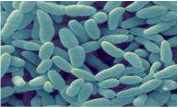
It is used in the commercial production of vinegar, as fermentation starter cultures, and is found in gut microbiomes of some living organisms.
Acetobacter aceti bacteria are a widespread group of gram-negative, obligate aerobic rods which oxidize ethanol (alcohol) into ethanoic (acetic) acid. They occur mainly in sugary, acidic and/or alcoholic surroundings and play a positive, neutral, or detrimental roles in food and beverages. It can be found in mangoes, bananas, sugar cane, sweet potato, coffee, cameroon grass, ragi, tea, pineapple, and mealy bugs.
Acetobacter aceti causes cloudiness or haziness, ropiness, discoloration, and a change in flavor in some beer. It can also infect wine, producing acetic acid and ethyl acetate levels that make the drink unpalatable.
Acetobacter orientalis is nitrogen-fixing bacteria found in sugar cane, rice vinegar (komesu, kirosu), Caucasian yogurt ("Caspian Sea Yogurt). It can be also found in the gut of fruit flies.
Acetobacter hetogenum and Gluconacetobacteria dominate microbial communities in fermented tea kombucha.
Gluconacetobacter xylinus - formerly known as Acetobacter xylinum, xylinus and also called Gluconacetobacter kombuchae and Gluconacetobacter hansenii, produces microbial cellulose, used in the Filipino desert Nata de coco.
Acetobacter
- Acetobacter Beijerinck, 1898 (Approved Lists, 1980)
- Acetobacter aceti (Pasteur 1864) Beijerinck 1898
- Acetobacter aceti (Pasteur 1864) Beijerinck 1898
- Acetobacter cerevisiae Cleenwerck et al. 2002
- Acetobacter cibinongensis Lisdiyanti et al. 2002
- Acetobacter diazotrophicus Gillis et al. 1989
- Acetobacter estunensis (Carr 1958) Lisdiyanti et al. 2001
- Acetobacter europaeus Sievers et al. 1992
- Acetobacter hansenii Gosselé et al. 1983.
- Acetobacter indonesiensis Lisdiyanti et al. 2001
- Acetobacter intermedius Boesch et al. 1998
- Acetobacter liquefaciens (Asai 1935) Gosselé et al. 1983
- Acetobacter liquefaciens (Asai 1935) Yamada and Kondo 1985
- Acetobacter liquefaciens (Asai 1935) Yamada and Tahara, 1984
- Acetobacter lovaniensis (Frateur 1950) Lisdiyanti et al. 2001
- Acetobacter malorum Cleenwerck et al. 2002
- Acetobacter methanolicus Uhlig et al. 1986
- Acetobacter oboediens Sokollek et al. 1998
- Acetobacter orientalis Lisdiyanti et al. 2002
- Acetobacter orleanensis (Henneberg 1906) Lisdiyanti et al. 2001
- Acetobacter pasteurianus (Hansen 1879) Beijerinck and Folpmers, 1916
- Acetobacter peroxydans Visser't Hooft 1925
- Acetobacter pomorum Sokollek et al. 1998
- Acetobacter syzygii Lisdiyanti et al. 2002
- Acetobacter tropicalis Lisdiyanti et al. 2001
- Acetobacter xylinus corrig. (Brown 1886) Yamada, 1984
